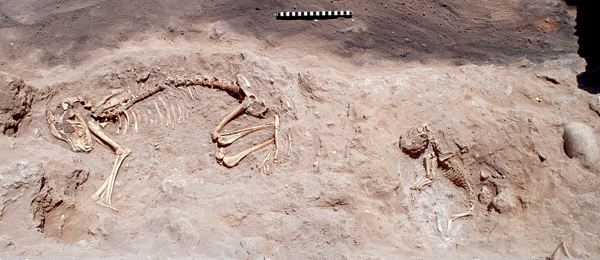The Dog Days of Ashkelon
Sidebar to: Caleb the Dog

Dogs have been a part of human life in ancient Israel and the Near East for almost as long as the archaeological record of the region. The remains of a presumably domesticated dog dated to 10,000 B.C.E. have been found in a cave in Iraq, and a puppy skeleton has been found in northern Israel next to that of a boy in a grave attributed to the Natufian period (12,000-8500 B.C.E.). However, the most extraordinary archaeological evidence of close relations between man and dog in antiquity is the fifth-century B.C.E. dog cemetery found at Ashkelon, in Israel.
Located on a bluff overlooking the Mediterranean Sea, this cemetery contains the remains of at least 700 dogs, according to Ashkelon excavator Lawrence Stager of Harvard University.a They appear to have been interred with great care, usually in the same pose, with legs flexed and tail tucked in around the hind legs, as shown in the photo. Zooarchaeologists Paula Wapnish and Brian Hesse, who examined the skeletons, noted that they bear no signs of butchering and their ages are appropriate for the mortality rates of an average urban canine population. The dogs apparently died of natural causes.
Already a library member? Log in here.
Institution user? Log in with your IP address.

